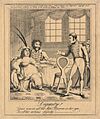Samuel Pechell facts for kids
Quick facts for kids
Sir Samuel Pechell, Bt
|
|
|---|---|
| Born | 1 September 1785 Ireland |
| Died | 3 November 1849 (aged 64) Berkeley Square, London |
| Allegiance | |
| Service/ |
|
| Years of service | 1796–1849 |
| Rank | Royal Navy Rear-Admiral |
| Battles/wars | French Revolutionary Wars • Capture of Néréide • Capture of Africaine Napoleonic Wars • Action of 13 March 1806 • Action of 22 January 1809 • Invasion of Martinique |
| Awards | Companion of the Order of the Bath, Knight Commander of the Royal Guelphic Order |
| Other work | Whig MP for Helston (1830) and Windsor (1832–1835). Lord of the Admiralty (1830–1834, 1839–1841) |
Sir Samuel John Brooke Pechell (born September 1, 1785 – died November 3, 1849) was an important officer in the British Royal Navy. He lived in the early 1800s. He fought in famous naval battles during the French Revolutionary Wars and the Napoleonic Wars.
However, his biggest achievements came later. He worked as a Lord of the Admiralty. This meant he helped lead the Navy. He focused on making naval gunnery faster and more accurate. He did this by creating new training methods and manuals.
Pechell also served in the House of Commons. This is part of the British government. He was friends with King William IV. The King supported Pechell's ideas for better gunnery training. Pechell inherited the title of Baronet from his father in 1826. He had no children, so the title went to his brother, George, when he died.
Contents
Where and When Was Samuel Pechell Born?
Samuel Pechell was born in Ireland in 1785. His father was Sir Thomas Brooke Pechell, a senior army officer. Samuel came from a family of military leaders. Both his grandfathers were high-ranking army officers. His uncle, John Borlase Warren, became a senior naval officer. Samuel's younger brother, George, also became a well-known naval officer.
At just 11 years old, Samuel joined the Royal Navy. His uncle helped him get started. He joined HMS Pomone in 1796. This was during the French Revolutionary Wars. The next year, he moved to HMS Phoebe. He served under Captain Robert Barlow for four years.
Early Battles and Promotions
While on Phoebe, Pechell fought in two important battles. Phoebe captured the French ship Néréide in 1797. Then, in 1801, they captured the French ship Africaine. Pechell was highly praised for his bravery in these fights. He was promoted and continued to serve with Captain Barlow.
In 1803, he became a lieutenant on HMS Active. In 1806, he joined his uncle's ship, HMS Foudroyant. He was there when they defeated a French fleet.
First Command and Famous Victory
In 1807, Pechell got his first command. He was in charge of the small ship HMS Ferret near Jamaica. In 1808, he was promoted to captain. He took command of the frigate HMS Cleopatra. His ship joined a fleet preparing to attack French islands.
His most famous battle was in January 1809. He found the French ship Topaze hiding near Guadeloupe. Even though the shore batteries were firing, Pechell attacked. He brought Cleopatra very close to Topaze. His attack was so effective that Topaze could not fight back. With help from two other British ships, he successfully captured Topaze.
Later Service and Retirement
The next month, Cleopatra helped in the successful invasion of Martinique. Later, Pechell's ship returned to Europe. In 1812, he became captain of HMS San Domingo. This ship was the main ship for the North America Station during the War of 1812. Pechell did not see much action during this war. He returned to Britain in 1814. The war ended in 1815, and Pechell mostly retired from active service. He received an award, the Companion of the Order of the Bath, for his service during the Napoleonic Wars.
Life After War and Political Role

In 1823, Pechell returned to active duty on the ship HMS Sibylle. He worked off Algiers and the Peloponnese. His job was to fight piracy, which had increased due to the Greek War of Independence. In 1826, he returned home. His father died, and Samuel became a Baronet. He also added "Brooke" to his last name.
Serving in Parliament
In 1830, he entered politics. He became a Whig Member of Parliament (MP). He represented Helston for a short time. Then he was elected for Windsor, serving until 1835. In 1833, he married Julia Maria Petre.
Pechell's most important work in the 1830s was as a Lord of the Admiralty. He was very passionate about improving gunnery training in the Navy. As a captain, he had studied and improved a system for accurate shooting. He even wrote a pamphlet about it.
When he gained a position of power, he worked to share his ideas. King William IV supported him. The King had also been a naval officer and believed in gunnery training. Pechell worked with Sir Howard Douglas and Sir William Bowles. Together, they created HMS Excellent. This was the Royal Navy's first ship dedicated to gunnery training. Pechell also helped appoint Sir William Symonds as the Surveyor of the Navy. Because of his work, Pechell is seen as a key person in making the Navy more professional in the later 1800s.
During his time in office, Pechell was promoted to Rear-Admiral. He also received another award, the Knight Commander of the Royal Guelphic Order. He died in London in November 1849. He had no children, so his younger brother became the next Baronet.
Images for kids
-
Caroline of Brunswick and Bartolomeo Pergami, with Pechell defending the Prince of Wales's honour in a contemporary cartoon


